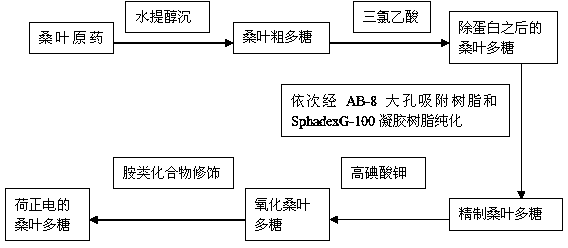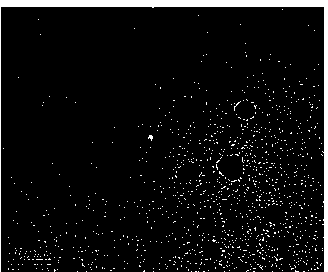Cationized mulberry polysaccharide nanoparticle gene vectors and manufacturing method thereof
A mulberry leaf polysaccharide, cationization technology, applied in the direction of nanotechnology, nanomedicine, nanotechnology, etc., can solve the problems of lack of biodegradable polypeptide immunogenicity, high cytotoxicity, etc., to increase biological functions, prepare The process is simple, the effect of good combination and release effect
- Summary
- Abstract
- Description
- Claims
- Application Information
AI Technical Summary
Problems solved by technology
Method used
Image
Examples
Embodiment 1
[0032] Example 1. Preparation of Refined Mulberry Leaf Polysaccharide
[0033] Weigh 120g of dried mulberry leaves, crush them into powder, and pass through a 60-mesh sieve; extract according to the following process: solid-liquid ratio: 1:12, extraction temperature: 85°C, extraction time 2h / time, extraction times: 2 times; combine two The second extraction solution was centrifuged at 5000rpm for 10min, and the supernatant was taken; then the supernatant was concentrated by rotary evaporation to 1 / 6 of the original volume to obtain a concentrated solution; the concentrated solution was precipitated with 95% medical alcohol until the alcohol concentration was 75%, stand at 4°C for 12 hours; collect the precipitate, wash twice with absolute ethanol, acetone, and ether in turn; dry in vacuum to obtain the crude polysaccharide of mulberry leaves.
[0034] Weigh 3g of mulberry leaf crude polysaccharide, dissolve it completely in 40ml of double-distilled water, add 20% trichloroa...
Embodiment 2
[0037] Example 2. Preparation of Oxidized Mulberry Leaf Polysaccharide
[0038] Weigh 0.5g refined mulberry leaf polysaccharide, dissolve in 30ml double distilled water, add 0.8g KIO 4 , quickly placed in a dark room, stirred magnetically, and reacted at room temperature for 72 hours; adding 12ml ethylene glycol to the reaction solution to terminate the reaction, and continued the reaction for 30 minutes according to the aforementioned conditions; put the reaction solution into a dialysis bag, and dialyzed in double distilled water for 48 hours; Obtain oxidized mulberry leaf polysaccharide.
Embodiment 3
[0039] Example 3. Preparation of cationized mulberry leaf polysaccharide modified by ethylenediamine
[0040] Take 0.3g of oxidized mulberry leaf polysaccharide and dissolve it in 20ml of double distilled water; take 0.1ml of ethylenediamine and dissolve it in 5ml of borate buffer solution (pH=9); Add it into the mulberry leaf polysaccharide solution, and carry out magnetic stirring at the same time; after the addition, magnetically stir, and react at room temperature for 24 hours; after that, add 0.4g sodium borohydride to the reaction solution, and continue the reaction for 48 hours under the same conditions; then add to the reaction solution 0.4 g of sodium borohydride, and continue to react for 24 hours under the same conditions; put the reaction solution into a dialysis bag, and dialyze in double distilled water for 48 hours; freeze-dry the dialysate to obtain cationized mulberry polysaccharide modified with ethylenediamine.
PUM
| Property | Measurement | Unit |
|---|---|---|
| particle diameter | aaaaa | aaaaa |
| molecular weight | aaaaa | aaaaa |
| number average molecular weight | aaaaa | aaaaa |
Abstract
Description
Claims
Application Information
 Login to View More
Login to View More - R&D Engineer
- R&D Manager
- IP Professional
- Industry Leading Data Capabilities
- Powerful AI technology
- Patent DNA Extraction
Browse by: Latest US Patents, China's latest patents, Technical Efficacy Thesaurus, Application Domain, Technology Topic, Popular Technical Reports.
© 2024 PatSnap. All rights reserved.Legal|Privacy policy|Modern Slavery Act Transparency Statement|Sitemap|About US| Contact US: help@patsnap.com










